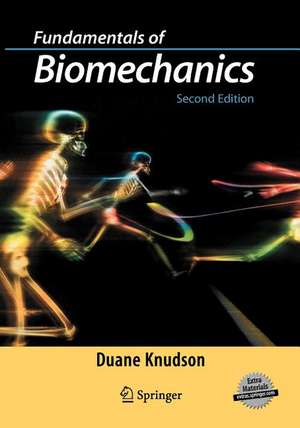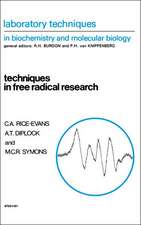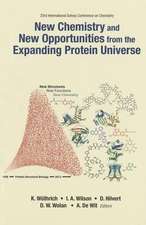Fundamentals of Biomechanics
Autor Duane Knudsonen Limba Engleză Paperback – 17 apr 2012
The text provides real-world examples of the application of biomechanics several ways. Like other texts, human movement examples and problems are discussed to help teach biomechanical variables and concepts. This text, however, goes beyond this physics class with sport example approach. First, nine principles of biomechanics are developed throughout the book to link theoretical knowledge with practical/professional principles and application. These nine generic application principles are based on the laws and concepts of biomechanics, so they can be applied to all human movements. There principles help PETE majors address standard 2 on applying movement concepts and principles in physical education (NASPE, 1995). Most biomechanics texts that have tried to develop principles for application have created many specific observations about many categories of human movement, so students tend to get lost. Second, the last section of the book develops the application of biomechanics in qualitative analysis of several movements in four professional areas: physical education, coaching, strength & conditioning, and sports medicine. These guided tours of the application of biomechanics to solve human movement problems are similar to the extensive interdisciplinary qualitative analysis tutorials in Knudson & Morrison (2002).
| Toate formatele și edițiile | Preț | Express |
|---|---|---|
| Paperback (1) | 718.26 lei 6-8 săpt. | |
| Springer Us – 17 apr 2012 | 718.26 lei 6-8 săpt. | |
| Hardback (1) | 568.13 lei 3-5 săpt. | +44.77 lei 7-13 zile |
| Springer International Publishing – 11 iun 2021 | 568.13 lei 3-5 săpt. | +44.77 lei 7-13 zile |
Preț: 718.26 lei
Preț vechi: 756.06 lei
-5% Nou
Puncte Express: 1077
Preț estimativ în valută:
137.45€ • 143.32$ • 114.24£
137.45€ • 143.32$ • 114.24£
Carte tipărită la comandă
Livrare economică 20 martie-03 aprilie
Preluare comenzi: 021 569.72.76
Specificații
ISBN-13: 9781441964977
ISBN-10: 1441964975
Pagini: 368
Ilustrații: XII, 354 p.
Greutate: 0.64 kg
Ediția:2nd ed. 2007
Editura: Springer Us
Colecția Springer
Locul publicării:New York, NY, United States
ISBN-10: 1441964975
Pagini: 368
Ilustrații: XII, 354 p.
Greutate: 0.64 kg
Ediția:2nd ed. 2007
Editura: Springer Us
Colecția Springer
Locul publicării:New York, NY, United States
Public țintă
GraduateCuprins
to Biomechanics of Human Movement.- Fundamentals of Biomechanics and Qualitative Analysis.- Biological/Structural Bases.- Anatomical Description and Its Limitations.- Mechanics of the Musculoskeletal System.- Mechanical Bases.- Linear and Angular Kinematics.- Linear Kinetics.- Angular Kinetics.- Fluid Mechanics.- Applications of Biomechanics in Qualitative Analysis.- Applying Biomechanics in Physical Education.- Applying Biomechanics in Coaching.- Applying Biomechanics in Strength and Conditioning.- Applying Biomechanics in Sports Medicine and Rehabilitation.
Textul de pe ultima copertă
Fundamentals of Biomechanics 2nd edition introduces the exciting world of how human movement is created and how it can be enhanced. The book presents a comprehensive review of the major concepts of biomechanics and summarizes them in nine principles of biomechanics. Throughout the text are numerous examples of applying these principles to the work of kinesiology professionals. Specific case studies are presented in four application chapters: physical education, coaching, strength and conditioning, and sports medicine. This text presents a clear, conceptual understanding of biomechanics and is designed to help students link their personal experience to biomechanical concepts. Biomechanics instructors, researchers, and other professionals helping people to improve movement and decrease the risk of injury, as well as advanced students learning biomechanical principles in biomedical engineering, ergonomics, kinesiology, physics, and sports physiology will find Fundamentals in Biomechanics 2nd edition invaluable.
Key Features:
Detailed examples of biomechanical principles and their application in the qualitative analysis of human movement in a variety of professions
Over 160 figures illustrating real human movement
Case studies of actual movement technique examined by professionals in human movement
Extensive use of graphs, photographs, illustrations, and citations to important biomechanics literature
Glossary of key terms and biomechanics research terminology
Appendix of instructional lab activities
Endorsements:
"Fundamentals in Biomechanics delivers everything it promises, and more. The challenge of teaching and learning biomechanics is understanding the two distinct fields that it comprises - biology and mechanics. In my experience, some students enter biomechanics with aptitude and interest in one of these fields and reluctance to the others. As a leader in biomechanics, Dr. Knudson seems to realize this and does an expert jobof teaching these two fields in separate parts of the textbook. The text is clearly written, and includes many helpful illustrations and examples."
Glenn S. Fleisig, Ph.D., Smith and Nephew Chair of Research, American Sports Medicine Institute, Birmingham, AL
"Fundamentals of Biomechanics is a wonderful and comprehensive treatment which meets the needs and interest of both students and educators! The text addresses the subject cohesively and solidly in a technical, yet very readable and effective manner...I'll use this text in my own summer course and recommend it to colleagues."
Jani Macari Pallis, Ph.D., International Sports Engineering Association, San Francisco, CA
About the Author:
Dr. Duane Knudson is Associate Dean and Professor of biomechanics in the Department of Kinesiology at California State University, Chico. He earned his Ph.D. in biomechanics from the University of Wisconsin-Madison and has published extensively on the biomechanics of tennis and exercise. Dr. Knudson co-authored the first scholarly book on the qualitative analysis of human movement, and his research has earned him fellow status in the American College of Sports Medicine and the Research Consortium of AAHPERD.
Key Features:
Detailed examples of biomechanical principles and their application in the qualitative analysis of human movement in a variety of professions
Over 160 figures illustrating real human movement
Case studies of actual movement technique examined by professionals in human movement
Extensive use of graphs, photographs, illustrations, and citations to important biomechanics literature
Glossary of key terms and biomechanics research terminology
Appendix of instructional lab activities
Endorsements:
"Fundamentals in Biomechanics delivers everything it promises, and more. The challenge of teaching and learning biomechanics is understanding the two distinct fields that it comprises - biology and mechanics. In my experience, some students enter biomechanics with aptitude and interest in one of these fields and reluctance to the others. As a leader in biomechanics, Dr. Knudson seems to realize this and does an expert jobof teaching these two fields in separate parts of the textbook. The text is clearly written, and includes many helpful illustrations and examples."
Glenn S. Fleisig, Ph.D., Smith and Nephew Chair of Research, American Sports Medicine Institute, Birmingham, AL
"Fundamentals of Biomechanics is a wonderful and comprehensive treatment which meets the needs and interest of both students and educators! The text addresses the subject cohesively and solidly in a technical, yet very readable and effective manner...I'll use this text in my own summer course and recommend it to colleagues."
Jani Macari Pallis, Ph.D., International Sports Engineering Association, San Francisco, CA
About the Author:
Dr. Duane Knudson is Associate Dean and Professor of biomechanics in the Department of Kinesiology at California State University, Chico. He earned his Ph.D. in biomechanics from the University of Wisconsin-Madison and has published extensively on the biomechanics of tennis and exercise. Dr. Knudson co-authored the first scholarly book on the qualitative analysis of human movement, and his research has earned him fellow status in the American College of Sports Medicine and the Research Consortium of AAHPERD.
Caracteristici
Nine principles of biomechanics that are developed throughout the text. These principles provide an applied structure for biomechanical concepts, and the application of each principle is fully explored in several chapters The text continues the traditional approach of providing many human movement examples as biomechanical concepts are presented Practical application boxes that highlight in-depth discussions of applications of biomechanics Activity boxes that allow students to see or feel the effect of biomechanical concepts on human movement Interdisciplinary issues boxes that show how biomechanics is integrated with other sport sciences in solving human movement problems. These features provide real-world examples and emphasize how biomechanics is integrated with the other subdisciplines of kinesiology to contribute to qualitative analysis of human movement Key terms are bolded and defined in the text
Notă biografică
Dr. Duane Knudson is University Distinguished Professor of biomechanics in the Department of Health and Human Performance at Texas State University. He earned his Ph.D. in biomechanics from the University of Wisconsin-Madison and has published extensively on the biomechanics of tennis.exercise, stretching, and learning biomechanical concepts. He has published over 140 peer-reviewed articles, 22 chapters, and four books. He has been elected fellow of four scholarly societies (FNAK, FISBS, FACSM, RFSA) and received regional and national awards for his research.















